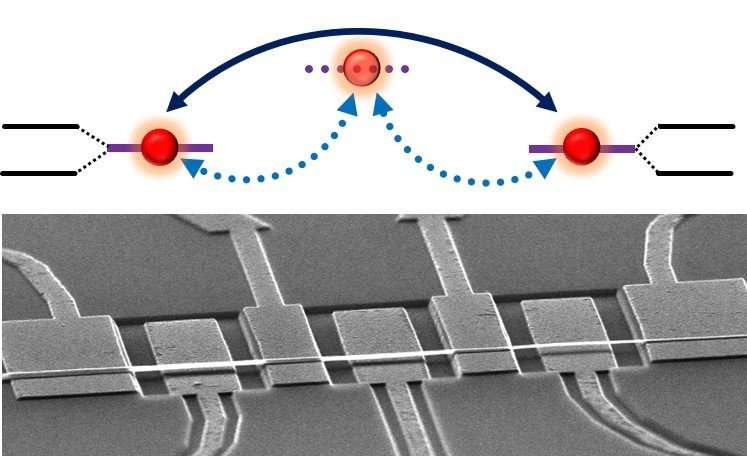Team realizes strong indirect coupling in distant nanomechanical resonators

Researchers at the University of Science and Technology of China have achieved strong indirect coupling between distant phonon modes by introducing a third resonator as a phonon cavity mode. Varying the resonant frequency of the phonon cavity mode, the coupling strength between distant phonon modes can be continuously tuned. The researchers have published an article titled "Strong indirect coupling between graphene-based mechanical resonators via a phonon cavity" in Nature Communications.
With the advantages of small size, stability and high quality factors, nanomechanical resonators are considered to be a promising candidate for storing, manipulating and transferring information. Both classical and quantum information can be encoded on phonon states of mechanical resonators. Phonon states can also transfer such information.
The main problem of using nanomechanical resonators as information carriers is achieving tunable phonon interaction at a long distance. The most common approach is to use optical cavities or superconducting microwave resonators as mediators. However, the difference between resonant frequencies of mechanical resonators and optical cavities or microwave resonators is too large. Also, it is difficult to induce a strong coupling regime as the coupling strengths between them are relatively small.
Focusing on this problem, researchers proposed employing a mechanical resonator to act as a phonon cavity to replace the optical cavity or microwave resonator. The resonant frequencies of phonon cavities and mechanical resonators are in the same range. Thus, these modes can be effectively coupled. Previously, the group realized strong coupling between neighboring mechanical resonators and coherent manipulation of phonon modes. Based on this work, the scientists designed and fabricated a linear chain of three graphene-based nanomechanical resonators, as shown in Fig. 1.
In this device, the resonant frequency of each resonator can be tuned in a wide range via local bottom metal gates, allowing the researchers to modulate the coupling between resonators in different frequency ranges. They observed the mode splitting of each neighboring resonator, which are strongly coupled. The results provide the foundation for the coupling between the first and the third resonator. When the resonant frequency of the center resonator is tuned near to that of the side resonators, high mode splitting can be observed. They found that the splitting can be tuned via the resonant frequency of the center resonator.
This phenomenon is similar to Raman process in optics. The center resonator can be regarded as a mediating state, the phonon modes of side resonators can achieve effective coupling via the exchange of virtual phonons with the mediating state (Fig. 1). Using the theoretical model of the optical Raman process, they found the relation between effective coupling strength and detuning. The experiment data agrees well with the theoretical results.
The study sheds light on the studies of nanomechanical resonators. With the development of the studies on phonon states cooling, this work provides the foundation for storage and transfer of quantum information via phonon modes.
More information: Gang Luo et al. Strong indirect coupling between graphene-based mechanical resonators via a phonon cavity, Nature Communications (2018). DOI: 10.1038/s41467-018-02854-4
Journal information: Nature Communications
Provided by University of Science and Technology of China



















